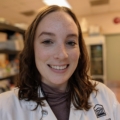Elevated brain α-synuclein, phosphorylated-tau, and oxidative stress in mice that survived influenza A pneumonitis
Output Details
Description
Influenza virus infection increases the incidence of parkinsonism in humans. We have previously shown that allelic variants at the Parkinson’s disease (PD)-linked *Lrrk2* locus modulate host responses *in vivo*. Here, we asked whether Lrrk2 kinase activity alters disease outcomes in adult mice that survived a nasally acquired infection. We inoculated mice with the mouse adapted A/Fort Monmouth/1/1947 influenza A virus, serotype H1N1 (LD50, 2×103 plaque forming units), leading to pneumonitis. We found that neither the hyperkinase-active Lrrk2 p.G2019S knock-in mutant nor the kinase-dead Lrrk2 p.D1994S mutant altered the course of an acute H1N1 lung infection. We then probed for long-term effects of H1N1 pneumonitis on brain health by monitoring surviving mice for six weeks post-inoculation. Intriguingly, at this time point, when mice had recovered and showed no detectable viral proteins in the brain, levels of H2O2 and protein nitrotyrosination were significantly elevated in H1N1 survivors vs. mock-treated littermates. In addition, total α-synuclein concentrations were increased in an infection-dependent manner but independent of the *Lrrk2* genotype. Intriguingly, at the same timepoint, the ratio of phosphorylated-to-total tau (but not total tau itself) was significantly increased in the brains of H1N1-virus exposed Lrrk2 p.G2019S mice compared to wild-type animals. Our collective results demonstrate that a preceding pneumotropic influenza A virus infection can lead to a rise in several neurodegeneration-linked markers in the brains of surviving mice. The increased ratio of phosphorylated-to-total tau in Lrrk2 p.G2019S animals adds to the growing evidence of interactions between specific microbial pathogens and allelic variants at the *Lrrk2* locus. The described outcomes in animals that survived an influenza A virus infection may be of relevance to the incidence of neurodegenerative diseases in ageing humans.





